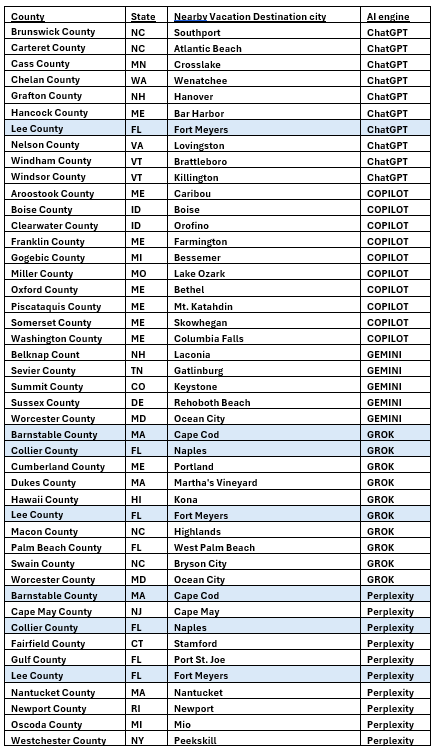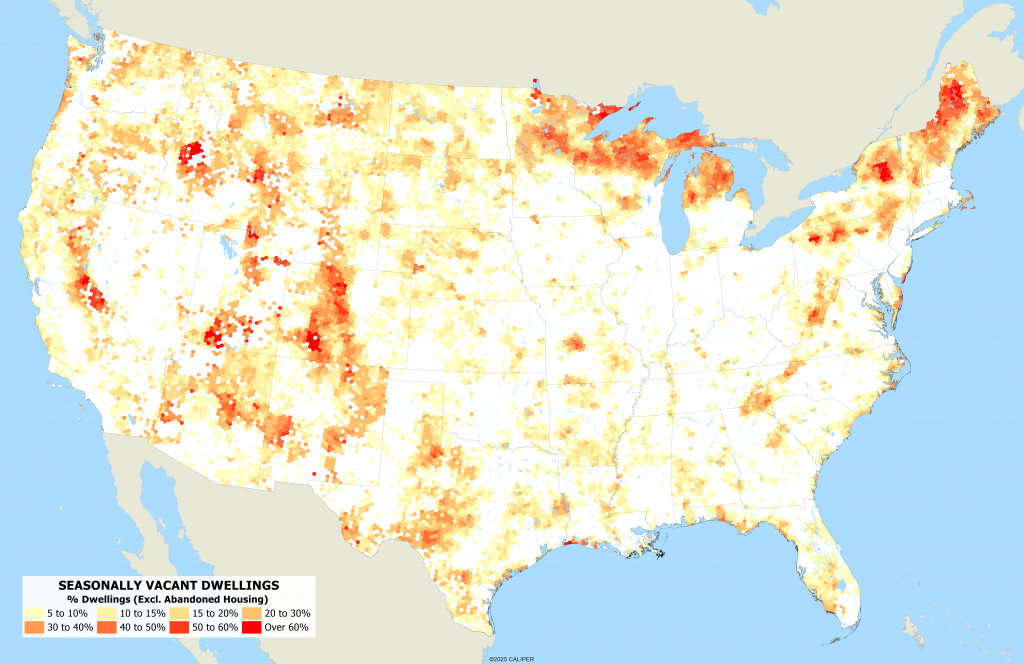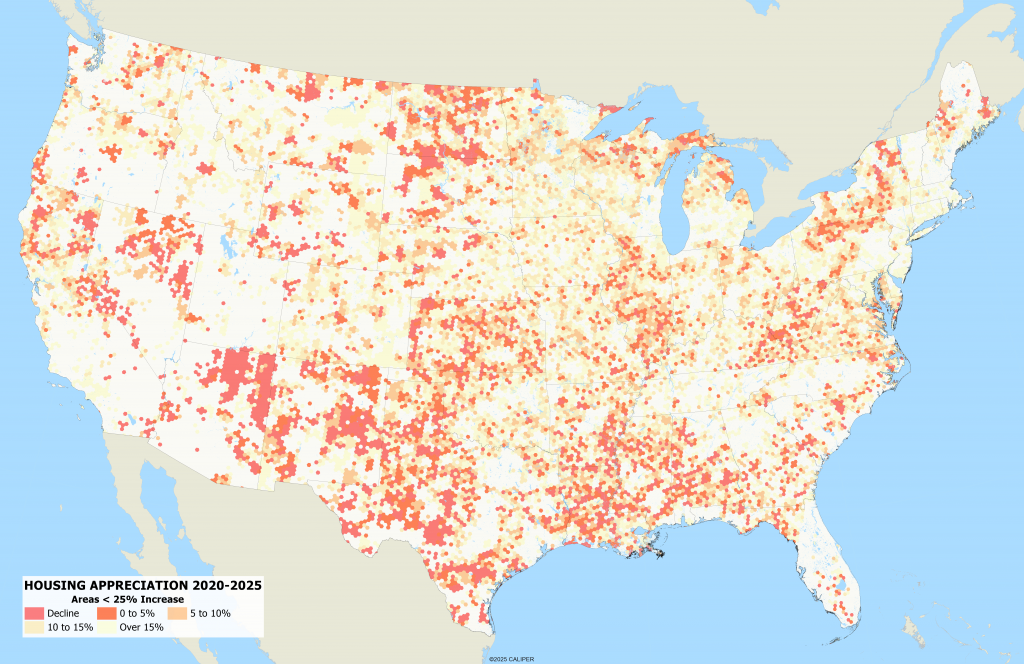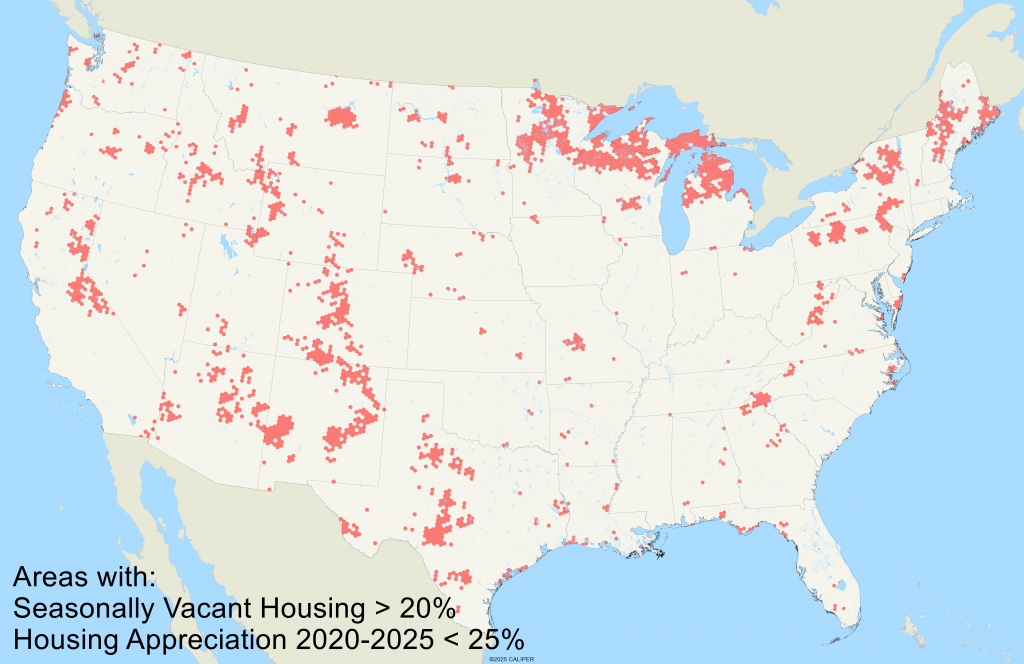Want to find the ideal vacation spot this summer and maybe look for the ideal second home? Maybe you are thinking that you can work there part-time and mix business with pleasure. You may ask where can I find the best vacation spot but without spending too much money?
What to do? Well, ask AI, right? Asking five of the most popular chatbots for the answer should narrow the choices! Almost. Not quite. Maybe not at all.
Background
A few weeks ago, AGS published a map of the U.S. counties with the highest percentage of vacation rentals and second homes in a blog called “The Summer Urban Exodus.” The objective was to see where everyone was going for a well-deserved summer vacation. It was the starting point, but perhaps a slightly different question should be asked.
As illustrated by most online property search applications like Zillow and Redfin, we know that prices of homes have been appreciating substantially, especially in areas that are popular vacation destinations. The pandemic sent people out of urban enclaves and those that had second homes in the mountains or at the beach saw their property values skyrocket!
Also, notably, retiring baby boomers have leveraged their large investment accounts into purchasing homes in the very places where people like to play golf, enjoy mountain views and plunge in the ocean. That is, in the very same locations as today’s vacation destinations.
AGS Finds the Hot Spots
The AGS map found the following:
Where people go is highly dependent upon where they live and what is affordable. In the east, affordable second properties are often found in the lake country of Minnesota and Michigan and along the Appalachian Mountains from Georgia to Maine. Beachfront property is expensive, but popular spots include the Jersey Shore, Cape Cod and the islands, the Delmarva Peninsula, and of course the Outer Banks of the Carolina coast… The situation in the far west is similar – beachfront property is out of reach for most unless it is well away from LA and San Francisco. The Central Coast from Ventura to Monterey appeals to both Giants and Dodgers fans. But the real action is in the mountains which we often think of as winter vacation spots but are, as anybody trying to get to Tahoe, Big Bear, or Sedona on a Friday night can attest, the big draws.
Enter AI
So, the AGS maps spurred a thought, and to go further this is the question:
What are the top 10 U.S. counties that have the highest percentage of second homes or vacation rentals and the lowest property appreciation over the last five years.
The objective was to isolate the cost variable such that some locations are favored as great vacation destinations but also didn’t suffer the huge appreciation of the most popular areas like Cape Cod, Massachusetts or Ventura, California.
So, OpenAI’s ChatGPT, Perplexity, Microsoft CoPilot, X’s Grok and Google Gemini were put to the test.
The results? Well, they were all over the map! Literally.

ChatGPT had great spatial diversity, choosing areas such as Carteret County NC (Emerald Isle), Grafton NH (Hanover), Windham County VT (Brattleboro), Cass County MN (Crosslake) and Chelan County WA (Wenatchee).
Perplexity was perplexing choosing some of the most expensive areas of the country including Westchester County NY (Peekskill), Nantucket MA, Newport County RI (Newport) and Fairfield County CT (Stamford).
Grok chose some of the highly popular areas including Hawaii County (big island), Dukes County MA (Martha’s Vineyard), Palm Beach County FL (West Palm Beach), and Worcester County DE (Ocean City), but are certainly not cheap.
CoPilot seemed to favor the state of Maine, selecting six counties, mostly in the East and Northwest parts of the state, as well as Idaho with Boise and Clearwater Counties. Cheap, but clearly distant locations for a large segment of the population.
Gemini was not up to the task and only chose five including some popular regions such as Sussex County DE (Rehoboth Beach), Summit CO (Keystone), and Sevier County TN (Gatlinburg).
Methodology
As anyone who has used AI chatbots to ask somewhat complex questions, many are excellent at explaining their methodology for arriving at their conclusions.
Grok was extremely thorough in providing its methodology but admitted that “I don’t have direct access to precise data on U.S. counties with the highest percentage of second homes or vacation rentals combined with the lowest property appreciation over the last five years (2020–2025). Comprehensive county-level data for this specific combination of metrics—second home/vacation rental prevalence and property appreciation—is not readily available in my sources or the web results provided.”
Perplexity cited numerous references of where I should look for data and compiled the results using “Top U.S. Counties with High Second Home/Vacation Rental Rates” and the “Counties with Lowest Property Appreciation (or Decline)” and then computed the results.
AGS’s Gary Menger noted, “GROK and PERPLEXITY are completely out to lunch – they chose vacation areas that have high appreciation. Note that we tossed Cape Cod off the list because of appreciation. This is also true for most of the Atlantic coast with a few exceptions. The outer banks of the Carolinas – you can’t see them easily – but they are not candidates because of major appreciation over the last few years. Newport County, RI? Seriously?”
Gemini offered me a cautious suggestion: Based on the available data from the recent searches, identifying counties with both a very high percentage of second homes/vacation rentals and the absolute lowest appreciation over the last five years is challenging, as comprehensive county-level 5-year appreciation data is not directly available for all counties listed with high second-home percentages.
Mapping Analysis by AGS
AGS then used its data to see if it could do a better job of answering the question and used its data to combine “Seasonally Vacant Dwellings” (Map 1) and “Housing Appreciation <25% Increase” (Map 2). The results are shown on the combined adjacent map (Map 3).



The map shows some promising suggestions: Carteret County, NC or locally known as the “Southern Outer Banks” pops up but if you are thinking that this is the ideal location don’t wait too long as it is a primary destination for the Raleigh-Durham (“The Triangle”) region where Interstate 42 is under construction and is a direct link to this region. And nearby Beaufort, NC is booming!
The Adirondacks and eastern New Hampshire near Lake Winnipesaukee are beautiful but still a long drive from downtown Manhattan, which is certainly why The Hamptons are a preferred destination but not affordable by most.
Great areas are identified for New Mexico, Central Idaho and the Rockies but these are areas that have been discovered already, and you’ll need to grab something quickly if that’s your preferred spot for a second home.
The Upper Peninsula of Michigan and the Land of 10,000 Lakes of Minnesota…well, that’s a far drive for everybody. You must want to really get away!
Take-aways
From the analysis there were some overlaps: Collier County, FL and Barnstable County, MA were identified by both Grok and Perplexity; Lee County, FL were identified by Grok, Perplexity and ChatGPT. I expected to see more overlap, but I also expected Southern Appalachia, noted by the Wall Street Journal last year as a destination for Baby Boomers moving out of Florida to find more affordable homes in areas like Gatlinburg TN or Asheville NC.
Menger noted, “Yes, New England, especially Maine has areas that match the criteria, but you can forget a coastal house in most areas. If you want a cottage, the UP (Upper Peninsula) of Michigan is a good choice, but there are also some pockets all the way down the Appalachians that fit the bill.”
The take-away is that access to authoritative demographic information and property data is essential and that it is either not available from public sites like the U.S. Census, Bureau of Economic Analysis or, more likely, is proprietary data from sources such as CoStar or Cotality and other property technology and data companies. The methodology of the AI chatbots may be sound, but the sources of data matter most. And, you may still have to hire a realtor to find that hidden gem.


Recent Comments